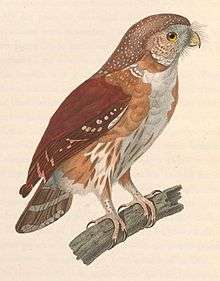East Brazilian pygmy owl
| East Brazilian pygmy owl | |
|---|---|
 | |
| Scientific classification | |
| Kingdom: | Animalia |
| Phylum: | Chordata |
| Class: | Aves |
| Order: | Strigiformes |
| Family: | Strigidae |
| Genus: | Glaucidium |
| Species: | G. minutissimum |
| Binomial name | |
| Glaucidium minutissimum (Wied-Neuwied, 1821) | |
| Synonyms | |
| |
The East Brazilian pygmy owl (Glaucidium minutissimum), also known as least pygmy-owl or Sick's pygmy-owl, is a small owl in the typical owl family.
Taxonomy
It has been argued that the here used scientific name actually belongs to the Pernambuco pygmy owl, in which case the East Brazilian pygmy owl should be referred to G. sicki (König & Weick, 2005).[2] This has not gained widespread recognition.[3]
Formerly, this species included the Colima pygmy owl, Tamaulipas pygmy owl, Central American pygmy owl, subtropical pygmy owl,[1] and Baja pygmy owl[4] as subspecies.
Distribution
This species has a very large range. It can be found in eastern Brazil, in far eastern Paraguay,[5] in Belize, Bolivia, Colombia, Costa Rica, Guatemala, Honduras, Panama, and Peru.[1]
Habitat
It inhabits tropical and subtropical moist evergreen forests and edges as well as open bush canopy.[6]
Description
It is one of the smallest South American owls, averaging at 55 grams (1.9 oz) and 15 cm (6 in). Wing length can reach 85–91 millimetres (3.3–3.6 in), while the tail can reach a length of 49–54 millimetres (1.9–2.1 in). The head is rounded, with no ear tufts. The pale greyish-brown facial disk is not pronounced and shows some rufous concentric lines. The eyes are yellow, with whitish eyebrows. The upper part of the body is relatively dark, rufous-brown with small white spots. Wings are dark brown and relatively short. The tail is dark brown with five pale bars. The lower part of the body is light gray or white, with reddish-brown stripes. The throat shows a rounded whitish area. The legs are feathered, with bristled and yellowish toes. Claws are horn with dark tips. The beak is yellow-green.[5][7]
Biology
The East Brazilian pygmy owl mainly feeds on small insects and sometimes catch small vertebrates. It is active at dusk and dawn, but occasionally hunts during the day. Song of the male is two-four long notes separated by short pasuses.[5][7]
References
- 1 2 3 BirdLife International (2012). "Glaucidium minutissimum". IUCN Red List of Threatened Species. Version 2013.2. International Union for Conservation of Nature. Retrieved 26 November 2013.
- ↑ König, C. & F. Weick. (2005). A new Least Pygmy Owl (Aves: Strigidae) from southeastern Brazil. Stuttgarter Beitr. Naturk. Ser. A. no. 688.
- ↑ South American Classification Committee (2008). Change the name of Least Pygmy-Owl to Glaucidium sicki. Accessed 21-11-2008.
- ↑ Lepage, Denis (2003–2007), Avibase - the world bird database, retrieved Sep 22, 2007
- 1 2 3 Owl Pages
- ↑ Weick, Friedhelm (2006), Owls (Strigiformes): Annotated and Illustrated Checklist, Springer, p. 164, ISBN 978-3-540-35234-1
- 1 2 Steve N. G. Howell and Mark B. Robbins SPECIES LIMITS OF THE LEAST PYGMY-OWL (GLAUCIDIUM MINUTISSIMUM) COMPLEX
